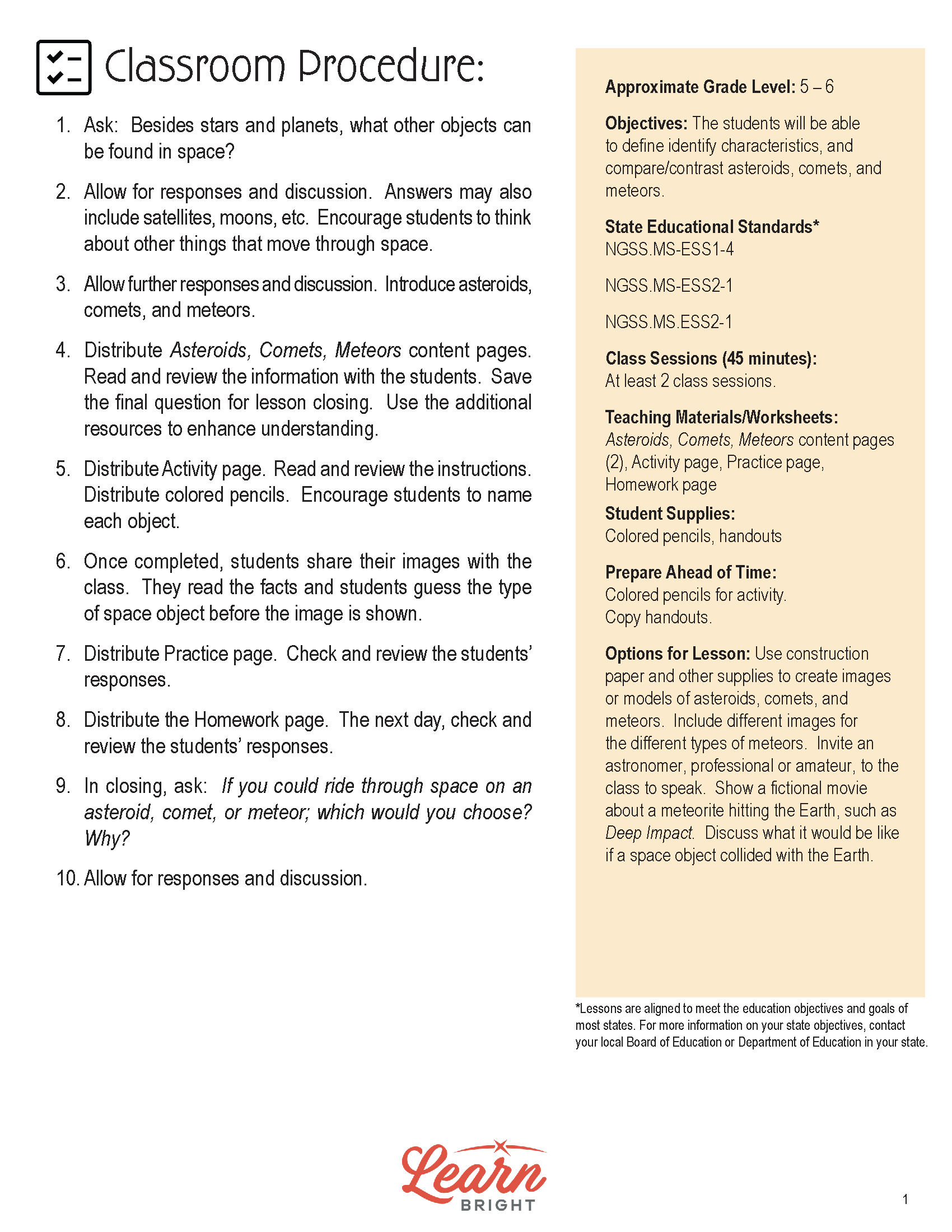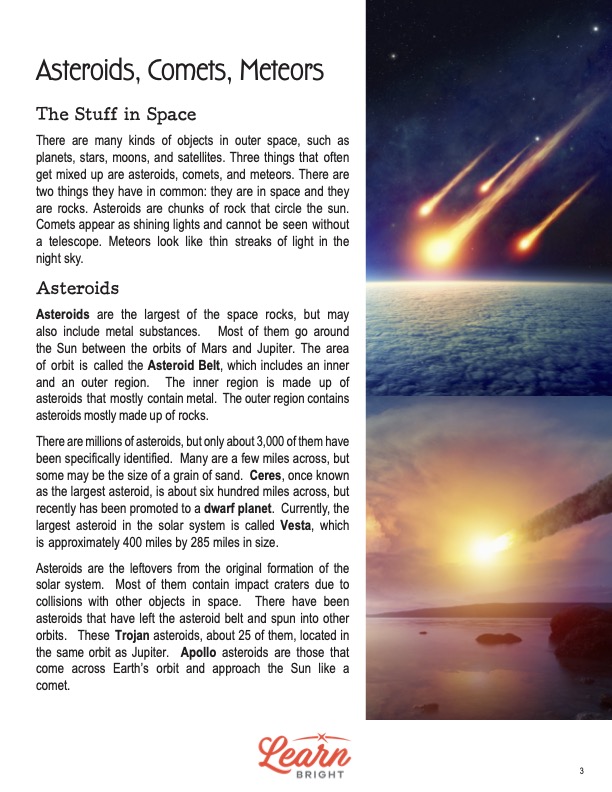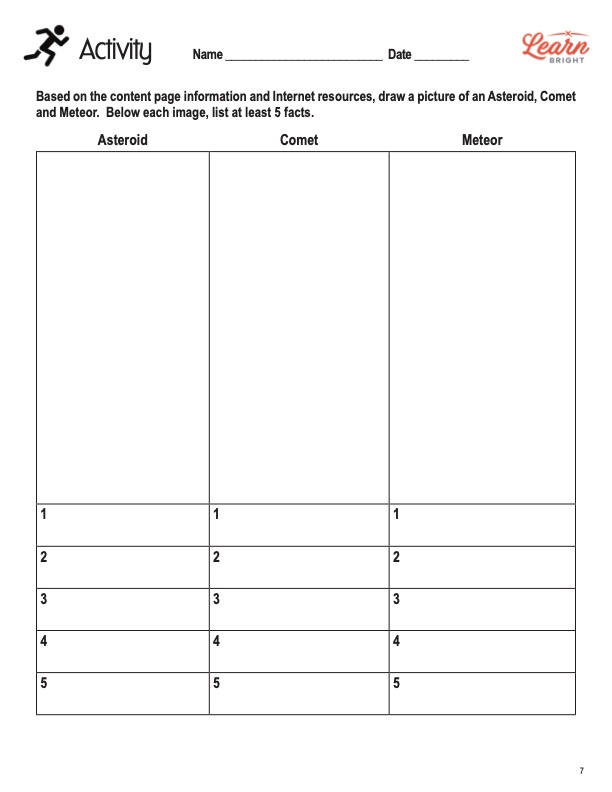Description
What our Asteroids, Comets, Meteors lesson plan includes
Lesson Objectives and Overview: Asteroids, Comets, and Meteors explores these three space rocks and their traits. Students will learn to compare and contrast the three types of “rocks” and identify them when they see them. This lesson is for students in 5th grade and 6th grade.
Classroom Procedure
Every lesson plan provides you with a classroom procedure page that outlines a step-by-step guide to follow. You do not have to follow the guide exactly. The guide helps you organize the lesson and details when to hand out worksheets. It also lists information in the yellow box that you might find useful. You will find the lesson objectives, state standards, and number of class sessions the lesson should take to complete in this area. In addition, it describes the supplies you will need as well as what and how you need to prepare beforehand.
Options for Lesson
In the “Options for Lesson” section of the classroom procedure page, you will see a number of suggestions for additional activities or tasks or alternative ways to go about aspects of the lesson. For the activity, students could use construction paper and other supplies to create images or models of the three space rocks. Another option is to invite an astronomer to come speak to the class and answer questions for your students. You could also show a fictional movie about a meteorite hitting the earth. If you choose to do so, ensure students get permission from their parents if needed. Another suggestion is to discuss what it would be like if an object from space collided with the earth.
Teacher Notes
The teacher notes page provides an extra paragraph of guidance or information as you prepare the lesson. It suggests taking advantage of students’ curiosity about space and teaching the lesson in conjunction with others about space or astronomy. You can write any thoughts or ideas you have on the lines of the page as you prepare to deliver the lesson to your students.
ASTEROIDS, COMETS, METEORS LESSON PLAN CONTENT PAGES
Asteroids
The Asteroids, Comets, Meteors lesson plan contains four pages of content. The first page discusses that there are many objects floating around in space, such as planets, stars, moon, and satellites. There are also a few types of space rocks that people often confuse. All three are in space and are rocks, but they are not the same.
Asteroids are chunks of rock that circle the sun. They are the largest of the three space rocks and sometimes have metal substances within them. Most asteroids circle the sun between the Mars and Jupiter orbits. Astronomers call this area the asteroid belt, which includes both inner and outer regions. The inner region contains asteroids that are mostly metal while the outer region contains asteroids that are mostly rock.
While there are millions of asteroids, scientists have specifically identified only about 3,000 of them. Some are as wide as many miles while others are as small as a grain of sand. Ceres was once the largest asteroid in the asteroid belt but is now considered a dwarf planet. Vesta is now the largest asteroid at approximately 400 miles by 285 miles in size.
Students may wonder where asteroids come from. The lesson explains that they are the leftovers from the original formation of the solar system. Most of them show impact craters from colliding with other objects in space. Some have left the astroid belt and spun into other orbits.
Comets
A comet is like a large snowball filled or covered by dust, metal, and debris because of its icy core, which is covered in a layer of black dust. This core is comprised of mostly water and gases that froze and mixed together with bits of rock and metal. Comets in the outer parts of the solar system are too far away to see from Earth.
Students will learn that the ice within a comet melts and changes into a gas as it approaches the sun. The dust particles spread out around the nucleus in a cloud called a coma. The sun’s light reflects off the comet, causing it to glow. The size of the coma of an average comet is 60,000 miles across, but it is very thin. Radiation and solar wind drive the coma’s gases away, causing it to form a straight tail, which can grow to 90 million miles in length!
If comets are close enough to the sun and pass Earth, people can see them without the use of a telescope. Astronomers can then identify them as comets as opposed to other types of space objects. Comets come from either the Kuiper Belt or the Oort Cloud. The Kuiper Belt lies beyond the orbit of Neptune, and the Oort Cloud is beyond the outer boundary of the solar system.
There are two types of comets: short-period and long-period. Short-period comets take fewer than 200 years to travel around the sun. These comets come from the Kuiper Belt. Long-period comets, on the other hand, have orbits that last more than 200 years. Some even take longer than 1,000 years. Long-period comets come from the Oort Cloud.
Meteors
Students will then learn all about meteors. These space rocks are what people often call shooting or falling stars. However, they are not stars at all. They are basically small pieces of rock or metal that originated from a comet or asteroid. They form when astroids collide or from the debris of a comet.
Meteors begin as meteoroids that travel toward the earth’s atmosphere. Astronomers don’t call them meteors, however, until they actually enter the earth’s atmosphere due to earth’s gravity. When this happens, the meteor heats up and burns, leaving what looks like a bright streak of light in the night sky. The term we use to describe events when many meteors breach the atmosphere is a meteor shower.
If a meteor does not burn up after entering the earth’s atmosphere and instead falls to its surface, it becomes a meteorite. It may surprise students to learn that millions of meteors enter the earth’s atmosphere every single day, but only a few of them reach the surface as meteorites. Around 500 meteorites hit the earth per year. Most of them land in oceans. Scientists have discovered them on land as well, generally in deserts or cold places like Antarctica. The climates in these regions preserves the meteorite.
The last page of the lesson provides a table that summarizes the information students learned throughout the lesson by listing a few basic facts about each type of space rock. The table lists their sizes, substances, sources, and numbers. It can be a useful tool for students as they complete the worksheets.
ASTEROIDS, COMETS, METEORS LESSON PLAN WORKSHEETS
The Asteroids, Comets, Meteors lesson plan includes three worksheets: an activity worksheet, a practice worksheet, and a homework assignment. Each handout will help students solidify their grasp of the lesson material. The guide on the classroom procedure page outlines when to give students each worksheet.
DRAW YOUR OWN ACTIVITY WORKSHEET
Using the content pages and internet resources, students will draw a picture of an asteroid, a comet, and a meteor. Below each image, they will write five facts that relate to the correct rock. You may have students work together for the activity, either as partners or in small groups, if you wish.
ASTEROIDS, COMETS, METEORS PRACTICE WORKSHEET
The practice worksheet includes multiple sections. The first section lists 10 facts. Students must determine whether the fact relates to asteroids (a), comets (C), or meteors (M). The next section contains eight names. Students must mark whether the name is for an asteroid (A) or a comet (C). Next, students will match the meteor information to the correct term. There are four sentences and four terms in the word bank to match. Finally, students will write a short paragraph about the difference between a short-period and a long-period comet.
MATCHING HOMEWORK ASSIGNMENT
The homework assignment requires students to match 20 statements or facts to the correct term from the word bank. There are 20 terms, so students will only use each term once.
Worksheet Answer Keys
The final two pages of the lesson plan document are answer keys for the practice and homework worksheets. The answers are in red to make it easy to compare with student responses. For the most part, students’ answers should reflect those of the answer keys. However, there may be some variation on the final prompt of the practice worksheet. If you choose to administer the lesson pages to your students via PDF, you will need to save a new file that omits these pages. Otherwise, you can simply print out the applicable pages and keep these as reference for yourself when grading assignments.











